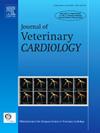病媒传播的病原体和心脏 Striatin 基因型对患有致心律失常性右室心肌病的拳师犬存活率的影响
IF 1.3
2区 农林科学
Q2 VETERINARY SCIENCES
引用次数: 0
摘要
导言/目的对患有致心律失常性右室心肌病(ARVC)的拳师犬出现严重疾病的风险因素尚不十分清楚。本研究旨在确定患有 ARVC 的拳师犬的 Striatin 基因型或犬病媒病原体 (CVBP) 暴露/感染是否与疾病严重程度或存活率有关。通过超声心动图和 Holter 监测确定疾病严重程度。潜在的危险因素包括 CVBP 暴露/感染(阿那普拉斯菌属、巴贝斯菌属、巴顿氏菌属、伯氏杆菌、密螺旋体、埃立克次氏体和立克次体)和 Striatin 基因型。结果入组后的中位生存时间为 270 天(95% 置信区间 [CI]:226-798 天),死亡或剔除时的中位年龄为 11 岁(95% CI:10.3-11.7 岁)。纹蛋白突变基因型结果包括 31 只同型阴性、26 只杂合阳性和 7 只同型阳性拳师犬。10只拳师犬接触过巴顿氏菌属,4只接触过立克次体,2只接触过埃希氏菌属,1只接触过阿纳普拉斯菌属。 Striatin基因同型阳性的拳师犬中位存活时间较短(93天,而杂合阳性为373天[P=0.010],同型阴性为214天[P=0.036])。讨论ARVC条纹素同源阳性拳师犬的存活时间较短,死亡时年龄较小。研究局限性选择病情较重的狗的偏差限制了评估 CVBP 感染/接触与病情严重程度之间关系的能力,总体样本量较小也限制了统计能力。心外疾病和治疗方案未得到控制。结论三尖杉碱基因型筛查可作为预后信息的参考。接触/感染 CVBP 似乎不太可能影响患有 ARVC 的拳师犬的存活时间。本文章由计算机程序翻译,如有差异,请以英文原文为准。
The role of vector-borne pathogens and cardiac Striatin genotype on survival in boxer dogs with arrhythmogenic right ventricular cardiomyopathy
Introduction/Objectives
Risk factors for severe disease in boxer dogs with arrhythmogenic right ventricular cardiomyopathy (ARVC) are not well understood. This study's objective was to determine whether Striatin genotype or canine vector-borne pathogen (CVBP) exposure/infection in boxer dogs with ARVC was associated with disease severity or survival.
Animals
Sixty-four client-owned, adult boxer dogs with ARVC were included in the study.
Materials and Methods
This was a prospective descriptive study. Disease severity was determined by echocardiography and Holter monitoring. Potential risk factors included CVBP exposure/infection (Anaplasma spp., Babesia spp., Bartonella spp., Borrelia burgdorferi, Dirofilaria immitis, Ehrlichia spp., and Rickettsia spp.) and Striatin genotype.
Results
The median survival time after enrollment was 270 days (95% confidence interval [CI]: 226–798 days), and the median age at the time of death or censoring was 11 years (95% CI: 10.3–11.7 years). Striatin mutation genotype results included 31 homozygous-negative, 26 heterozygous-positive, and seven homozygous-positive boxer dogs. Ten boxer dogs had exposure to Bartonella spp., four to Rickettsia, two to Ehrlichia spp., and one to Anaplasma spp. Striatin homozygous–positive boxer dogs had a shorter median survival time (93 days vs. 373 days for heterozygous [P=0.010] and 214 days for homozygous negative [P=0.036]). Exposure/infection to CVBP was not associated with median survival time or age at the time of death.
Discussion
Striatin homozygous positive boxer dogs with ARVC had shorter survival times and were younger at the time of death. Exposure or infection with CVBP did not appear to influence survival time.
Study Limitations
Selection bias for more severe disease limited the ability to assess the relationship between CVBP infection/exposure and disease severity, and overall small sample size limited statistical power. Extracardiac disease and treatment protocols were not controlled.
Conclusions
Striatin genotype screening can be considered for prognostic information. Exposure/infection to CVBP appears unlikely to influence survival time for boxer dogs with ARVC.
求助全文
通过发布文献求助,成功后即可免费获取论文全文。
去求助
来源期刊

Journal of Veterinary Cardiology
VETERINARY SCIENCES-
CiteScore
2.50
自引率
25.00%
发文量
66
审稿时长
154 days
期刊介绍:
The mission of the Journal of Veterinary Cardiology is to publish peer-reviewed reports of the highest quality that promote greater understanding of cardiovascular disease, and enhance the health and well being of animals and humans. The Journal of Veterinary Cardiology publishes original contributions involving research and clinical practice that include prospective and retrospective studies, clinical trials, epidemiology, observational studies, and advances in applied and basic research.
The Journal invites submission of original manuscripts. Specific content areas of interest include heart failure, arrhythmias, congenital heart disease, cardiovascular medicine, surgery, hypertension, health outcomes research, diagnostic imaging, interventional techniques, genetics, molecular cardiology, and cardiovascular pathology, pharmacology, and toxicology.
 求助内容:
求助内容: 应助结果提醒方式:
应助结果提醒方式:


